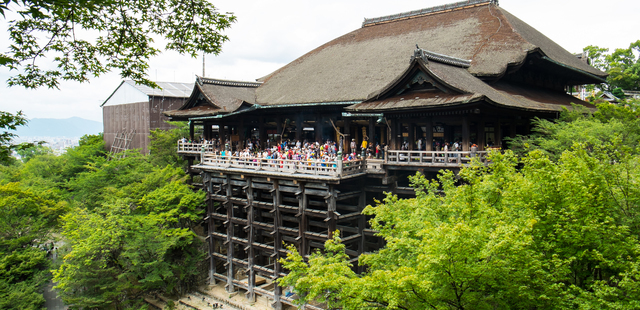Showing 44 attractions
9
6 reviews
The ceremonial rooms are embellished with paintings finished with gold, exemplary works of the Kano school, lavishly decorated coffered ceilings and superb tokonoma, altars which honour the ancestors. — Michelin Guide
The present structure dates from 1855. It's hardly palatial, though fine in its way; the ingenious cypress-bark roof is particularly attractive. — Fodor's
8
4 reviews
Breathtakingly modern though half a millennium old, its sculpted sand garden would transport anyone into a Zen state (if not for the crowds). — Concierge
8
3 reviews
This museum displays sculpture, Japanese paintings, ceramics, clothing and kimono, lacquerware, metalworks, and other treasures, most of which were once in Kyoto's many temples. — Frommer's
8
3 reviews
The harmony and beauty of Katsura Imperial Villa arises from its austere layout, which was to inspire Bauhaus architects as well as Le Corbusier. — Michelin Guide
The riverside 685-year-old Zen monastery has 24 temples on the property. — Travel + Leisure
The solemn stones set into the sand at Ryoan-ji's rock garden has become one of Japan's quintessential images. — Fodor's
8
3 reviews
Kodai-ji, a temple founded in 1606 by the widow of a high-ranking nobleman, was partially destroyed by fire. — Michelin Guide
If you arrive in Kyoto by train, you will find that the station, the first building you see, has paradoxically opted for modernity. — Michelin Guide
Hang out with samurai at this movie-set theme park from Toei, producer of Japanese period dramas and superhero shows. — Time Out
8
3 reviews
Nanzen-ji is an awesome sight, and has played a significant part in popularising Zen Buddhism in Kyoto. — Time Out
Possibly the world's most ostentatious retirement cottage, the magnificent gold-sheathed Kinkaku-ji was built by Shogun Yoshimitsu Ashikaga (1358–1409). — Fodor's
8
4 reviews
One of Kyoto's most awe-inspiring spectacles, this 400-foot-long hall holds 1,000 golden statues of the many-limbed Kannon. — Fodor's
The museum is known for its collection of modern Japanese paintings, with an emphasis on the artistic movements in the Kansai region. — Fodor's
7
2 reviews
The massive vermilion torii gate of Heian Jingu is one of Kyoto's best-known symbols. — Fodor's
This Museum was opened in 1978 by the 14th generation of the Raku family, a long line of ceramic artists. — Michelin Guide
1 - 20 of 44 results






























































